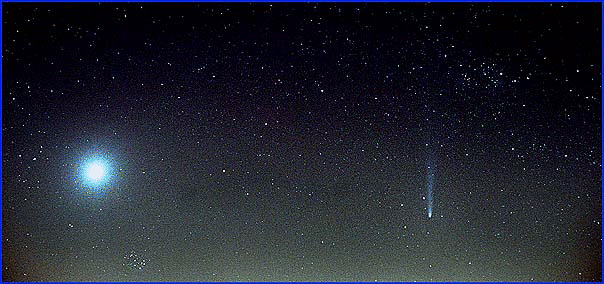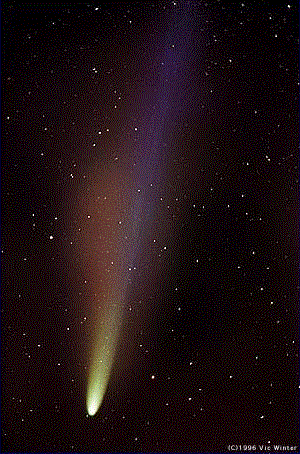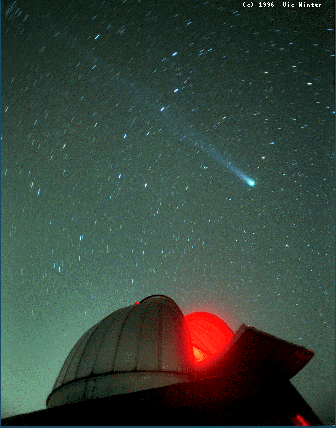
Comet Hyakutake


Comet Hyakutake is shown photographed the night of March 27 in Arizona, USA, with a cactus in the foreground. Polaris, the north star, is the bright star seen just to the upper right of the comet's head. Today Comet Hyakutake reaches its closest approach to the Sun. Comet Hyakutake is now at its intrinsic brightest, but because of its distance from the Earth, it will appear less bright to us than it did during its closest approach to the Earth in late March. In fact, due to the comet's angular proximity to the Sun, it will difficult to see at all from the Earth! Comet Hyakutake will reach less than one quarter of the Earth-Sun distance - inside the orbit of Mercury. Comet Hyakutake will not venture near the Sun again for another about 15,000 years.

It was a starry night in April (April 9th, 1996, 9:32 pm CDT to be exact) near Lone Jack, Missouri when Comet Hyakutake graced this astronomically rich field. Making an appearance as the brilliant evening star, Venus is overexposed at the far left. Just below Venus and slightly to the right, the Pleiades star cluster (M45) glistens. On the right hand side of the image, the comet itself shows a bright blue tail extending upwards past the nearby star cluster in the constellation Perseus (top right, the Alpha Persei Group).

What makes comet tails so colorful? This photograph of Comet Hyakutake was taken the night of April 18th and highlights different components of the tail. The gold and red tail features are dust, made predominately of little bits of rock and carbon. The dust tail shines by reflecting sunlight. Extending past the dust tail is the comet's ion tail, shown here glowing in blue. The ion tail is composed mostly of ions of water, carbon monoxide, and cyanogen. The ion tail glows by emitting light when elections re-combine with electrically charged ions to make uncharged molecules. The photograph was taken just north of Kansas City, Missouri, USA.

In one of the more spectacular pictures yet taken, Comet Hyakutake is shown here on March 26 high in the dark Missouri sky. In the foreground is Elmcrest Observatory complete with a dim red light glowing inside the dome. The stars in the background moved slightly during the exposure causing them to appear as streaks instead of points of light. Nevertheless, the constellation of Ursa Major - including the Big Dipper - is visible. Can you spot it? (Hint: Hyakutake's tail flows through the Dipper's handle.) Photographs with both recognizable foreground and background objects visible can be quite striking as they add angular perspective and contrast to the outworldly and unfamiliar comet. Dare anyone try to compete with city lights and capture the Eiffel Tower or the New York skyline in front of the comet?

Comet Hyakutake is still visible as it continues its orbit around the Sun. The comet will brighten again in late April and early May. The above fascinating picture was taken with a three minute exposure. In the middle of the exposure, the photographer cleverly set off a flash, momentarily illuminating the foreground tree. The picture was taken on March 24th from Mount Teide in the Canary Islands, and the recorded tail length was over 50 degrees. Discoverer Yuji Hyakutake, whose last name means "100 warriors" is an amateur astronomer in Japan. Interested in comets since age 15, he discovered this comet while sitting on a rural mountain top searching dark skies with huge binoculars in early morning hours. Originally intending to check up on a comet he had discovered only one month earlier, Hyakutake was initially worried that the new fuzzy spot he had located was not really yet another comet! One unexpected result of his comet discovery is that now his family has trouble making phone calls because their telephone is always ringing.

This March 19th false-color picture of Comet Hyakutake from one of the most sophisticated ground based telescopes captures the area surrounding the comet's nucleus. A comet's nucleus - not directly visible here - is a solid dirty iceball probably no more than 10 kilometers across. This image shows, for the first time, features of irregular brightness in the coma surrounding the nucleus. The beginning of the ion tale is visible as the bright feature emanating from the right, approaching about 1000 km from nucleus. At the distance of the comet, the whole field captured here is roughly the size of the Earth.

Photographs and Explanatory Text courtesy of Astronomy Picture Of The Day Archive
Hubble Space Telescope ... Through The Looking Glass
 Back to Rock & Roll Heaven
Back to Rock & Roll Heaven